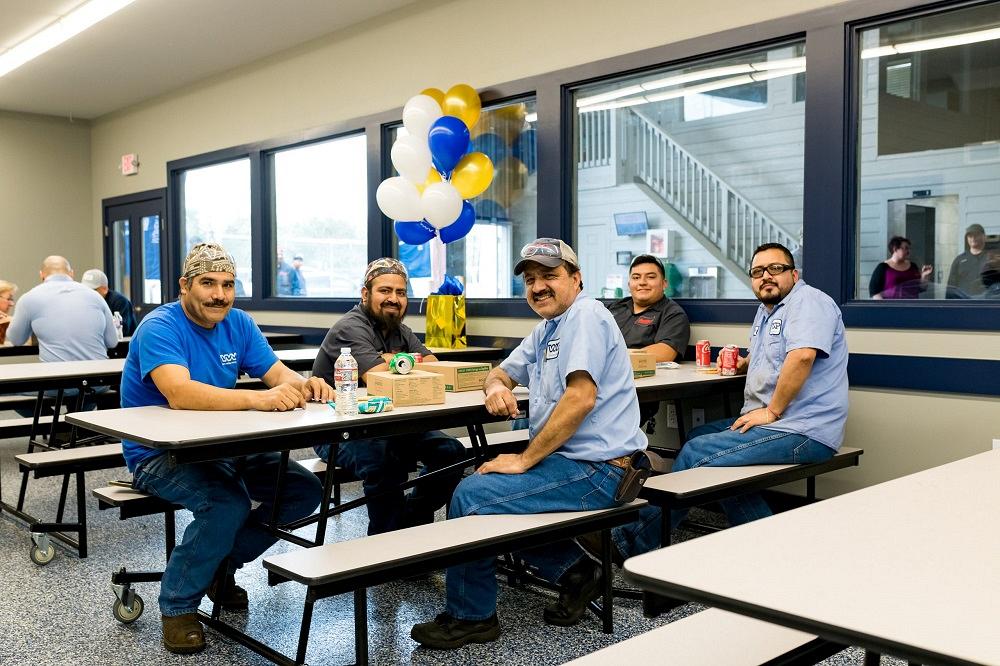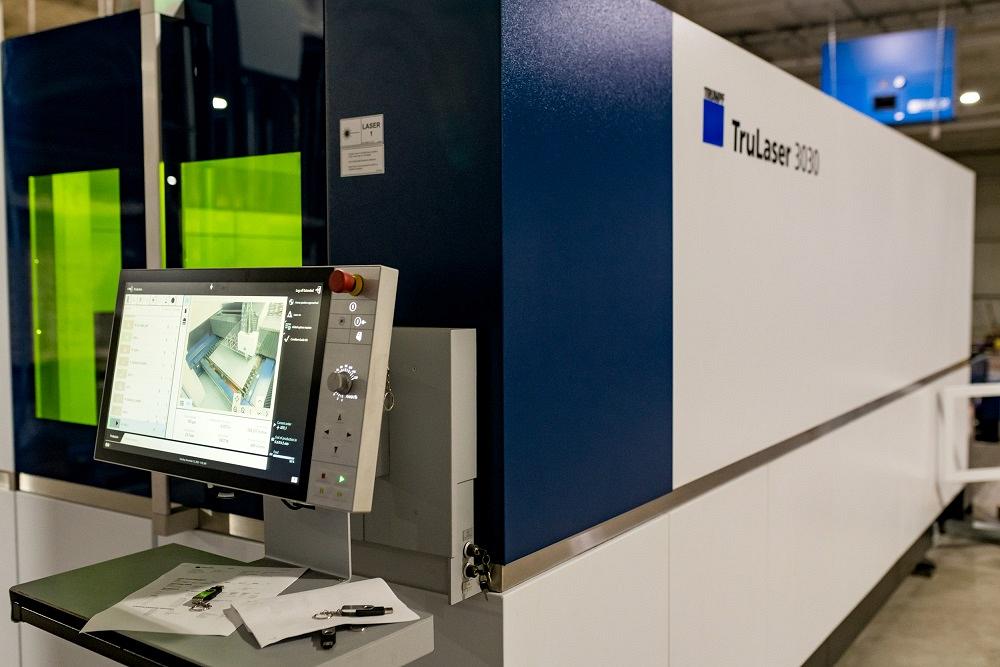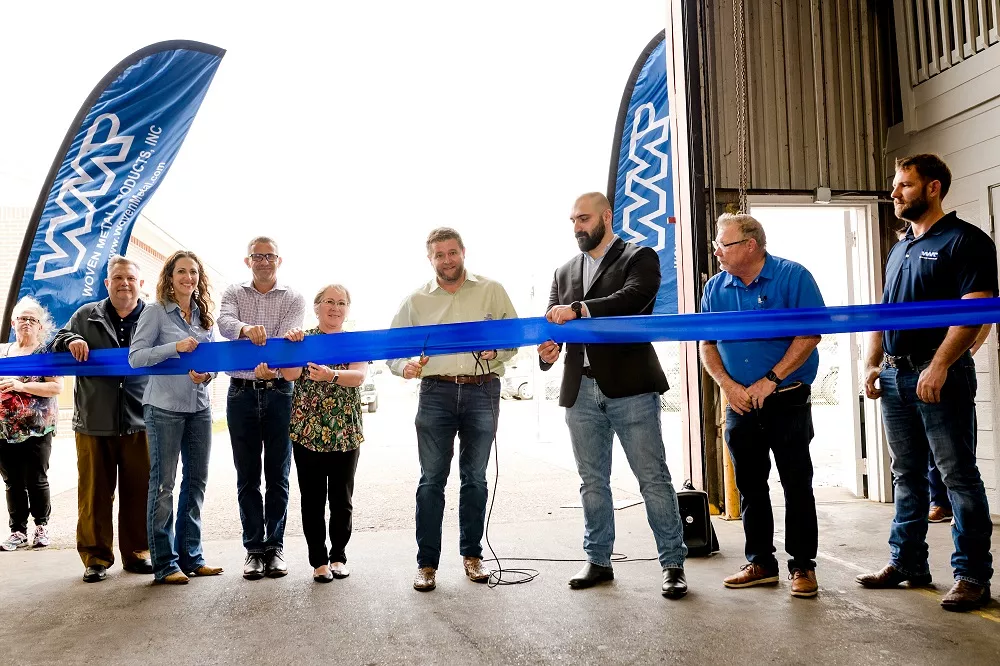The Fabricator – View Original Post
A name is not something that’s easily shed.
“When you’ve got a name, it sticks,” said Russell Hillenburg, president, Woven Metal Products (WMP), Alvin, Texas.
The Woven Metal Products name has been around since 1967. The company was formed to fabricate wire mesh products for Dow Chemical and evolved over the years as it served customers in the petrochemical industry. Soon after opening, it expanded its manufacturing expertise to things like center pipes with wire mesh, cover plates, catalyst support grids, and expander rings. That led them to being a supplier of other specialty internal parts, such as sieve and chimney trays, for the tower and vessel structures that dominate the landscape in petrochemical facilities. With the emergence of CNC technology, the company shifted to more perforated products and high-precision fabrications, eventually taking on general manufacturing work.
Today, Hillenburg thinks of WMP as a precision job shop that has extensive experience in the petrochemical industry. (Hillenburg said that the company has about 100 employees and close to 125,000 sq. ft. of manufacturing space. While the company prefers to keep annual sales confidential, Hillenburg did say that the company had doubled in size over the last 10 years. It experienced a 16% jump in sales in 2022 when compared to the previous year.) WMP still works with netted and woven wire on occasion, but it’s only a small percentage of the company’s overall business.
While the name may not encompass all the products the company makes, WMP is still very much a product of its legacy. The third-generation family company still keeps many of the same principles on which it was founded and which helped it to grow over the years. Hillenburg, who has been president since 2005, put it succinctly: “If you are going to build a business based on high quality, you have to build high-quality products.”
One Quality Standard for All Work
Working with the likes of Dow and Exxon in the early days, WMP needed to be aware of the specified tolerances and be able to deliver metal products that met those expectations. In the volatile world of chemical processing, almost isn’t good enough. The stakes are just too high.
That’s why the company was aggressive in working closely with its customers when it was just getting started. WMP principles not only helped supply key parts to these plants, they also were involved in helping to shape the specifications themselves. It established a reputation for metal fabricating expertise, and customers were more than willing to lean on them for manufacturing advice and metals knowledge.
WMP had a formal quality department dating back at least to the 1980s. That’s when documentation of processes started. And that process never stopped.
Hillenburg said he remembers when the company became ISO 9001:2015 registered in the early 2000s and the ease in which the accreditation agency had in verifying WMP met all of the criteria. When representatives from the certification body showed up, WMP quality officials presented their existing manuals for everything from welding processes to quality assurance steps.
“We didn’t have to do a lot to become ISO certified,” Hillenburg said.

At its updated 125,000-sq.-ft. facility, WMP fabricates products mainly for the energy and petrochemical sectors and is involved in precision sheet metal work.
“To this day, I’m very proud of our ISO audits,” he added. “We very rarely have a nonconformance issue. In fact, we haven’t had one for three years. Our team does an excellent job.”
High Precision, High Expectations
Customers in the petrochemical industry not only demanded high-quality product, but also high-precision ones. That attention to detail remains with the company to this day, according to Hillenburg.
“We build super-tight-tolerance stuff, down to machining tolerances, which you really wouldn’t expect in fabrication,” he said. “With that, sometimes you have to be able to go to step five and work your way backwards to see what it’s going to take to do step one and ultimately arrive at the tolerance you need.”
As an example, he described how a part designer might need to consider what the welded part will look like and then make adjustments in the specs for the preceding fabricating activities so that the part will end up where it needs to be. Maybe the part needs to be thicker to battle against warping during welding, or a part needs to be laser-cut instead of plasma-cut because a precise joint is required.
“Because we have all of these capabilities in-house, we’re able to put the right pieces together and then end up with a final product that makes customers happy,” Hillenburg said.
WMP has five CNC punching machines, a TRUMPF 6-kW laser cutting machine, a TRUMPF laser tube cutting machine, and a Flow 60,000-PSI waterjet to help it with its high-precision fabricating activities. On the machining side of the precision manufacturing coin, the company has a Haas mill and a Hass 12-in. lathe. It also has a Kinetic table with 5-axis, 800-amp plasma cutting capabilities and milling functionality.
Even with the metal fabricating technology and skill in place, mistakes do happen. A misinterpretation of a drawing might take place, or a simple miscommunication can occur. Hillenburg said that when it happens, WMP takes the necessary steps to make it right. The key, with the checks and balances in place to ensure quality on even the most high-precision work, is that the mistakes are not a regularly occurring thing.
Earned Design Expertise
WMP doesn’t have a roster of engineers to assist it with its design work, but that doesn’t mean it lacks mechanical and chemical engineering knowledge. After serving the petrochemical industries for more than 50 years, it knows what is required for fabrication of tower and reactor internals.
“This is knowledge that’s not taught in a classroom. It’s hands-on experience, and the knowledge is tried and tested,” he said. “There’s been a lot of trial and error over the years as well.”
To keep that knowledge from leaving the company, WMP has taken steps to let its employees know that opportunities await them at their current work address. Hillenburg said that over the past two years, WMP’s management team has created, updated, and formalized 45 job descriptions to provide better clarity on roles and growth paths for team members. Job performance reviews also have been formalized and a feedback loop implemented to provide guidance for personal growth and skills development.

A lot of the facility updates were targeted to improve employees’ time at the fab shop. One of those improvements included a new break room.
To help with that, Hillenburg said the company encourages cross-training on the fabrication shop floor. WMP enjoys the benefit of a more flexible workforce, and employees get to learn new skills and discover their areas of strength and interest. WMP also offers opportunities to pursue specialized certification, outside skills training, and leadership development programs.
All of this expertise and skills translate into a company that is not afraid to offer up its design expertise to customers looking for guidance. In fact, it’s often a value-add offering and a regular part of conversations with customers. Instead of just simply fabricating a replacement reactor or tower internal part, the WMP project manager might inquire about the application to see if any recommendations can be made for more efficiency.
Hillenburg said such an approach has led to several long-term customers. They welcome the input, and some work closely enough that both parties—the customer and WMP—wind up with a patent for a specific design.
Hillenburg offered up the development of an outside support grid (OSG) as an example. The part was designed to obtain a lower pressure drop in an axial flow reactor, which results in decreased energy consumption and increased production output. (An axial flow reactor comprises vessels situated vertically to allow for a gas or liquid to flow downwards through catalyst beds. The internal parts in such a device help to ensure that the catalyst remains viable and the process flow is suitable for maximum output.)
The proprietary OSG can achieve a decrease in pressure of up to 75% over traditional technology. It also is designed to sit at a lower position in the base of the vessel, which, compared to standard installations, allows for more media capacity in the reactor, in some cases up to 40% more. Hillenburg added that WMP’s input resulted in the OSG being quick to install. Also, the company only needs six weeks to fabricate one of the devices.
“With the addition of new technology and tools in our shop, we are able to automate mass fabrication in ways that we haven’t in the past,” he said.
These tools, such as finite element analysis and computational fluid dynamics, provide for quick and well-researched responses to customer inquiries or basic requests for quotes. It also bolsters the value-add design and engineering services that the company offers its customers.
Rapid Responsiveness
Dealing with rush orders is nothing new for metal fabricators. But for WMP, being an idustry supplier of precision woven wire and other products, the context of these special requests is unique. It’s not a product line that is shut down if parts are delivered. A significant portion of a refinery or a chemical plant is not going to be operating if some of these parts aren’t available.
“You know, these calls always come on Friday at 5 p.m.,” Hillenburg said, while laughing. “They call and say, ‘I need this tomorrow!’ We tell them we understand and get to work.”
WMP can be so responsive, according to Hillenburg, because it has invested heavily in fabricating technology that offers up some redundancy in capabilities. Even if a machine is tied up or down for maintenance, another piece of equipment is available.

A TRUMPF TruLaser 3030 laser cutting machine is one of the machine tools that now calls the newly renovated facility home.
That’s why capacity utilization is always a different discussion in this world of high-mix, low-volume production. While most industry pundits consider 80% capacity utilization a proper number for a successful manufacturing company, the owner or manager of a metal fabricating company might dismiss that idea. A fab shop needs the ability to take on a hot job and fit it into an already busy shift.
“You need to have excess capacity and the versatility in your shop floor to move things around, and our team is really good about juggling things around,” Hillenburg said.
Focused on the Future
WMP’s history has prepared itself nicely for the future. The elements of its early success are just as important now as they were in the 1970s and 1980s.
But there are no plans to rest on the company’s laurels and simply grow with the existing customer base. Hillenburg said he’d like to see the company continue to grow and build off the foundation laid by his predecessors.
“We have a lot of legacy here, and we have a lot of great people that want to take it to the next level and to the next level after that. They want to keep improving,” he said.
With the focus on the people of WMP, the company renovated its oldest building on the four-building campus and added a dedicated break room and bathroom facilities for the shop floor team. It also improved air filtration and circulation throughout all of the fabricating spaces and constructed office areas on the floor for better real-time communication among production, quality control, and design teams.
WMP is in the hands of a new generation of leaders and employees. They are in charge of defining what the name Woven Metal Products means to the current population of engineers and purchasers looking for metal fabricating services.

